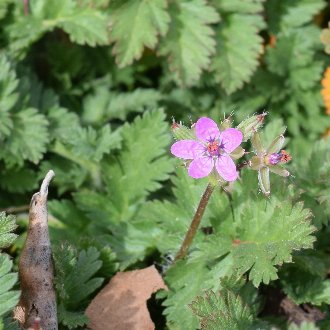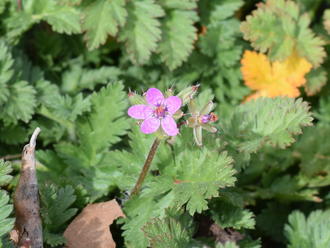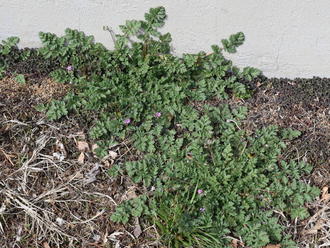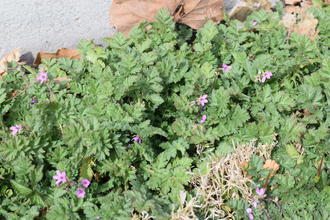Redstem Stork's Bill (Erodium cicutarium (L.) L'Hér. ex Aiton)
Also known as redstem filaree, common stork's-bill, pinweed.
↑Summary
An annual or biennial, native to the Mediterranean, and introduced in North America, where it is most abundant in the arid west, but also widespread throughout the continent.
↑Habitat
Prefers full sun and exposed conditions. Tolerates mesic conditions when there is less competition from other plants, but usually found in drier conditions. Sensitive to air pollution, especially sulfur dioxide. Prefers a mediterranean climate, but adaptable to a wide range of climates, including wet ones, and ones with cold winters and short growing seasons.
In the eastern U.S., where moisture is abundant, mostly found in anthropogenic habitats. The leaves grow close to the ground, making it able to survive regular mowing. Occasionally grows in drier parts of lawns, in south-facing exposures adjacent to buildings, and in narrow strips of mowed grass between parking lots, where the exposed conditions and reflected heat give this species a competitive edge against less drought-tolerant plants.
In the southwest, found in a variety of natural semi-arid habitats, including shrublands, meadows, and various montane habitats.
A dominant plant in annual grasslands of California's central valley.
↑Life Cycle
Erodium cicutarium is classified as an annual or biennial. It's life-cycle is predictably short, but it can be classified as a biennial because, especially in warmer climates the seeds often sprout in fall before the previous generations of plant have completely died down. In colder areas, the seeds may not sprout until spring.
Seeds usually germinate in response to rain, with greater germination under heavier rains. If it germinates in the fall, the plant establishes a small basal rosette of leaves which goes dormant over the winter.
Starts flowering in spring, and continues flowering sporadically through fall. Plants usually are able to flower within 2-4 months of germination.
If fruiting stems are removed, such as by grazing or mowing, the plant responds by producing new flowering stems low to the ground, which makes this plant well-adapted to both grazing and mowing. In the absence of mowing or grazing, the plant will grow more upright.
The seeds of this species exhibit some intriguing adapatations. Seeds become spring-loaded as they dry, and are launched from the parent plant, although most seeds fall relatively close. A spiral-shaped awn then expands and contracts in response to changes in humidity, often pulling the seeds deeper into the soil. Animals also aid in distributing the seed, particularly rodents, which cache the seed. Not all seeds germinate each year, and the plant can remain in the seed bank for years. The depth of the seeds helps protect them from surface fires and contributes to this species having a longer-term seed bank than many annuals.
↑Faunal Associations
This species co-evolved with domestic livestock in its native range. It is a preferred browse of livestock, which browse it heavily. Livestock likely also aid the spread of this plant by removing other vegetation and creating space for its seeds to germinate.
The seeds can also be distributed by animals; the same spiral mechanism that pulls the seed into the ground can get tangled in animal fur or stuck to paws, or also stick to human clothing, transporting the seeds to new sites. This species is usually considered a nuisance by pet owners because of its propensity to get stuck to pet fir and paws.
↑Control
Control methods of this species in North America are poorly developed, in part because people often encourage or even intentionally plant this species as a forage, and also because it is not usually regarded as among the most ecologically-damaging species. Most knowledge about control comes from the circumstances where this plant grows as a weed in annual crops.
In climates where these crops are grown, planting wheat or barley can be effective for controlling this plant because these two crops compete favorably against it. Related native cool-season grasses, such as wildryes (Elymus sp.) probably are effective at competing with it for similar reasons.
In spite of this plant being a favored browse of cattle and other mammals, grazing tends to favor this plant and is thus ineffective for controlling it. Similarly, it is well-adapted to fire and controlled burns tend to favor it (when conducted in spring or summer) or have no effect on it (when conducted in fall.)
Tillage can be used to control this plant, if the tilling is timed such that it occurs after this plant emerges in spring, but late enough that it is soon followed by a period where soil temperature rises to about 77°F (25°C) as the seeds do not germinate well in warmer temperatures. However such tillage may not be practical for growing certain crops, and may also have environmental costs.
Manual control is not practical where this plant occurs on a large scale, but for small infestations, plants can be pulled by hand before fruiting. Because it has a prolonged and variable bloom period, and germinates at different times of year, the area must be watched from spring through fall. Such control methods are not effective at permanently removing this plant, only at reducing its numbers, as it persists in the seed bank for a long time, and is so widespread where it occurs that recolonization is likely.
↑Uses
This species is an important forage for domestic livestock, including cows, horses, and sheep. It is sometimes intentionally planted for this purpose.
Although intentionally planted in some areas, it is considered a noxious weed in others.
The flowers are a source of nectar for honey.
↑Related Plants
There are other Erodium species in North America, including both native and introduced ones, but none are as common or widely distributed. Most occur only in isolated locations.
The broader Geraniaceae (geranium) family contains numerous species, both native and introduced.
↑Notes
The plant's common name "Stork's Bill" references the shape of its seedpods, which resemble a stork's open bill.
↑Links & External Resources
• Redstem Stork's Bill | Fire Effects Information System (FEIS) (About This Site)
• Erodium cicutarium (Storksbill) | Illinois Wildflowers (About This Site)
• Erodium cicutarium (Redstem Stork's Bill) | USDA PLANTS Database (About This Site)
• Erodium cicutarium | Go Botany (About This Site)
• Erodium cicutarium | Biota of North America Project (BONAP) (About This Site)
• Erodium cicutarium | NatureServe Explorer (About This Site)
• Erodium cicutarium | Missouri Plants (About This Site)
• Red-stemmed Storksbill | Maryland Biodiversity Project (About This Site)
• Erodium cicutarium (L.) L'Her. ex Ait. ssp. cicutarium (Common Storksbill, Heron's-bill, Red-stem Filaree, Alfileria) | Digital Atlas of the Virginia Flora (About This Site)






